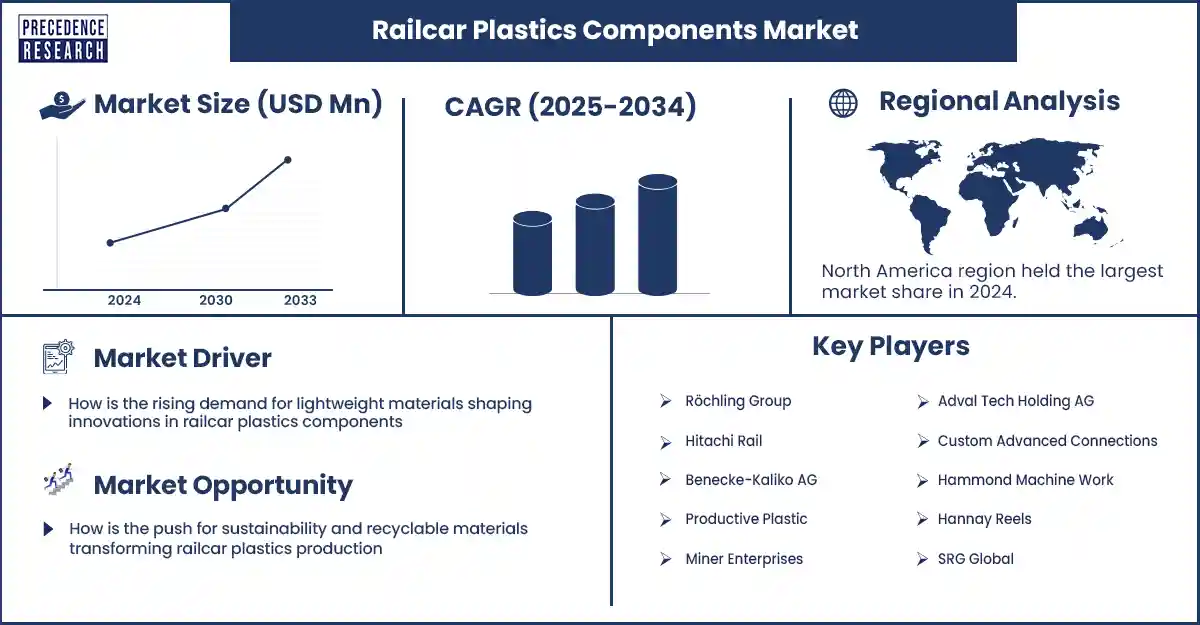Railcar Plastics Components Market Revenue and Forecast by 2033
Railcar Plastics Components Market Revenue and Trends 2025 to 2033
The global railcar plastics components market is driven by rising rail infrastructure investments, demand for lightweight parts, and innovations in high-performance polymer components. The railcar plastics components market is witnessing steady growth, driven by increasing demand for lightweight materials, improved fuel efficiency, and enhanced performance in modern rail transportation systems.

Railcar Plastics Components Market Overview
The railcar plastic components market is growing rapidly, primarily because of rising demand for lightweight, durable, and corrosion-resistant materials that improve fuel efficiency and minimize maintenance costs. Railcar plastic components are polymer-based materials (e.g., ABS, polycarbonate, polyethylene) wedged into a variety of freight or passenger railcar applications , making for added design flexibility, resistance to vibration, and life cycle benefits compared to older metal components; the unique chemical properties of polymer-based materials allow for constraints that are inherent in metal parts.
The progress toward energy-efficient transport and the introduction of tighter emissions standards around the world spur the use of polymer-based components. With the advancements around advanced composites and growing investment patterns in rail infrastructure, the market for railcar plastic components will continue expanding.
Segmental Analysis
- By Material Type- Thermoplastics take precedence in the market as a result of their durable and lightweight properties, coupled with considerable mold-ability which facilitates the manufacture of interior and exterior railcar parts easily.
- By Application- Interior components capture the interior components segment as plastics are overwhelmingly used in these applications across seats, panels, and flooring to maximize product aesthetics and comfort, while also being able to lower the weight of the railcar to improve energy efficiency.
- By Component- Non-structural components have the predominant segment of components because of a widespread use of plastic in decorative and protective applications, providing design flexibility, corrosion resistance, and lower maintenance than traditional metal components.
- By Manufacturing Process- Injection molding has the leading manufacturing process due to the level of accuracy, cost effectiveness, as well as ability to mass produce complex plastic railcar parts consists of qualities of uniformity and waste.
- By Distribution Channel- OEM is the dominating distribution channel, due to their incorporation of high quality plastic components during production for an assurance of reliability, safety, etc to encompass extended service life of railcars.
Regional Analysis
The North American railcar plastics components market is the largest, driven by a large, mature fleet and frequent refurbishment cycles as well as demanding safety and fire retardancy regulations. OEMs and aftermarket suppliers focus on high-performance polymers and engineered thermoplastics for interior parts, underbody protection, and lightweight panels to improve fuel efficiency. The strong freight rail segment along with the specialized car market (tank, hopper), and established suppliers, justify continued spending to replace or upgrade existing rails, hence the region remains of high value and specification-sensitive.
The Asia Pacific region has the highest growth prospects as railcar manufacturing in China, India, and Southeast Asia continues to grow alongside new urban transit projects and the rising volumes of freight. Cost-sensitive OEMs are adopting injection-molded plastic parts and using more composites to reduce weight and assembly time. The localization of supply chain, and government funding for rail infrastructure, fuels demand for both standard commodity parts and higher-performance polymer solutions for challenging climates or operating conditions.
Railcar Plastics Components Market Coverage
| Report Attribute | Key Statistics |
| Quantitative Units | Revenue in USD million/billion, Volume in units |
| Largest Market | North America |
| Base Year | 2024 |
| Regions Covered | North America, Europe, Asia-Pacific, Latin America, and the Middle East & Africa |
Key Players in Railcar Plastics Components Market
- Röchling Group
- Productive Plastics
- Swissplast
- Piedmont Plastics
- Salco Products, Inc.
- Miner Enterprises
- Hammond Machine Works
- Custom Advanced Connections
- TST Inc.
- Adval Tech Holding AG
- Kolzam S.A.
- SRG Global
- Benecke-Kaliko AG
- Helwig Carbon Products Inc.
- Hempel USA Inc.
- Herzog Railroad Services Inc.
- Hilliard Enterprises Inc.
- Hitachi Rail
- Handling Specialty Inc.
- Hannay Reels.
Get this report to explore global market size, share, CAGR, and trends, featuring detailed segmental analysis and an insightful competitive landscape overview @ https://www.precedenceresearch.com/sample/7019
You can place an order or ask any questions, please feel free to contact us at sales@precedenceresearch.com |+1 804 441 9344